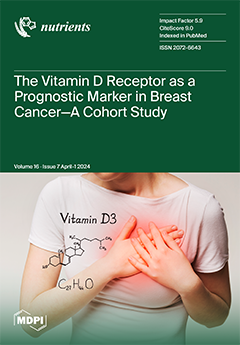Hip fracture is a common condition in older adults, leading to disability and mortality. Several studies have demonstrated the association between nutritional status and the risk of a negative health outcome after fractures. In this systematic review, we evaluated the association between malnutrition
[...] Read more.
Hip fracture is a common condition in older adults, leading to disability and mortality. Several studies have demonstrated the association between nutritional status and the risk of a negative health outcome after fractures. In this systematic review, we evaluated the association between malnutrition and mortality, changes in mobility/living arrangements, and postoperative complications, such as delirium, in older patients with hip fractures. A literature search on the PubMed, Web of Science, and Scopus databases, up to September 2023, was conducted to identify all studies involving older subjects that reported an association between MNA/GNRI/PNI/CONUT and health outcome after hip fracture. Meta-analysis was performed by a random-effects model using risk values (RR, OR, and HR) extracted from the 14 eligible selected studies. Malnutrition significantly increased the risk of any analyzed adverse outcome by 70% at 1 month, and up to 250% at 1 year. Malnutrition significantly increased delirium risk by 275% (OR = 2.75; 95% CI 1.80–4.18;
p ≤ 0.05), mortality risk by 342% (OR = 3.42; 95% CI 2.14–5.48;
p ≤ 0.05), mortality hazard risk by 351% (HR = 3.51; 95% CI 1.63–7.55;
p ≤ 0.05) at 1 month, and transfer-to-more-supported-living-arrangements risk by 218% (OR = 2.18; 95% CI 1.58–3.01;
p ≤ 0.05), and declined mobility risk by 41% (OR = 1.41; 95% CI 1.14–1.75;
p ≤ 0.05), mortality risk by 368% (OR = 3.68; 95% CI 3.00–4.52;
p ≤ 0.05), and mortality hazard risk by 234% (HR = 2.34; 95% CI 1.91–2.87;
p ≤ 0.05) at 1 year. Malnutrition of older patients increases the risk of death and worsens mobility and independence after hip fractures. The results of the present study highlight the importance of nutritional status evaluation of older subjects with hip fractures in order to prevent potential adverse outcomes (Registration No: CRD42023468751).
Full article






